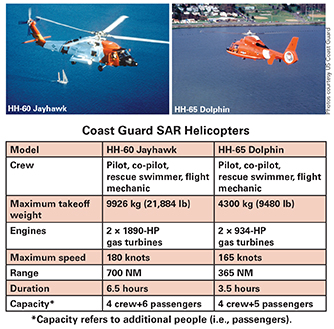How search and rescue procedures really work, with Michael Jacobs (published May 2014)
You’re 20 miles offshore and slogging to windward at 2 a.m. when one of your crewmembers reports that he just stepped from his berth into half a foot of water that is now sloshing back and forth in the main cabin. The bilge pump light shines valiantly from the distribution panel, but the boat starts to feel less and less responsive. You shout to the crewmember to wake everyone who is off-watch and to broadcast a mayday on the VHF to alert the Coast Guard that you’re taking on water. Lights go on below decks but then flicker and die as the water immerses the batteries. The source of the water can’t be found because it’s really dark, the flashlights can’t be found, and the sloshing water makes it impossible to figure out the source of the leak. The VHF, like the interior lights, is now kaput. The rest of the crew pulls on their foul weather gear and their personal safety gear and staggers on deck. One of them holds the ditch bag, containing a handheld VHF radio.
You pass the helm to one of the crew and switch on the VHF, quickly adjusting the squelch and volume. You’ve practiced using the radio, so you find the small flap on the side, lift it up, and press the small DSC button for several seconds. A few seconds later, the radio squawks with the voice of a Coast Guard watch stander who calls you on Channel 16: “This is the United States Coast Guard, Charleston, to the vessel in distress.”
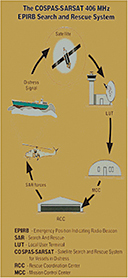 While the crisis may not be over, hearing the United States Coast Guard respond to a distress call is one of the sweetest sounds any sailor can hear when in danger. The Coast Guard men and women are standing by along the coasts and Great Lakes of the United States, prepared to render rescue services to sailors. What actually happens when you press the DSC button, or call the Coast Guard on Channel 16, or activate your EPIRB is the topic of this article.
While the crisis may not be over, hearing the United States Coast Guard respond to a distress call is one of the sweetest sounds any sailor can hear when in danger. The Coast Guard men and women are standing by along the coasts and Great Lakes of the United States, prepared to render rescue services to sailors. What actually happens when you press the DSC button, or call the Coast Guard on Channel 16, or activate your EPIRB is the topic of this article.
One note of caution, however. There is a level of risk involved in rescues at sea and despite the training and assets of the Coast Guard, or those of a professional mariner, a rescue can put the lives of the rescued, as well as the rescuers, in jeopardy. Requesting assistance when you’re tired, seasick and scared of continuing your voyage may seem like the right thing to do at the moment, but it should be avoided until there is demonstrable peril to the crew or the vessel. An alternate solution is to reduce sail, put the least tired crewmember on the helm and wait for dawn, for the wind to subside or to fetch a safe harbor that’s not too far away. Every year, seaworthy boats are abandoned at sea due to fatigued and seasick crews. You don’t want to be one of those crewmembers.
COMMUNICATING WITH THE COAST GUARD
The Coast Guard Rescue Coordination Center (RCC) can become aware of a mayday situation through one of several means: The Mission Control Center in Maryland can notify them of an EPIRB or PLB “hit” in their local area; they can receive a call on Channel 16; a cellular or satellite telephone call from a vessel; a report of a flare sighting or a vessel in distress from another vessel; or a report of an overdue boat that has failed to check in after a voyage.
Once you have determined that your situation requires outside assistance, you have two options to call for help: one-way communications (406-MHz emergency position-indicating radio beacon, abbreviated EPIRB) or two-way communications (either by radio—VHF or SSB—or mobile phone). Once the Coast Guard’s local RCC has been notified of a mayday situation, a Situation Coordinator assesses the nature of the danger to the vessel and crew, their distance away from shore and the assets available to aid in a rescue. The precision of the position of the vessel is paramount; searches become expensive, and less likely to result in a good outcome, if the positional accuracy is poor due to the passage of time or incomplete information.
Before leaving port, become familiar with the specific options and operations for the local SAR authorities including their landline number and how to call them and their available facilities. SAR capabilities vary considerably around the globe. The range and time of response depends on the specific assets and training of the respondents. In most cases, the local authorities will determine the best options for your rescue.
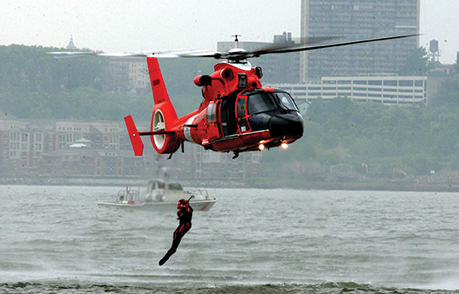
Prepare yourself and your crew in advance for these possible SAR protocols: The transfer of your crew to a Coast Guard or commercial ship in the area; a helicopter evacuation of the crew, if relatively close to shore; or an air drop from a Coast Guard or other rescue service aircraft.
SHIP RESCUES
In a ship-to-ship rescue the greatest risk is collision, so be prepared to lose your vessel in this situation. The typical ship-to-ship rescue scenario involves a large merchant ship with very limited maneuverability approaching a smaller vessel in distress, which may have almost no maneuverability. Because you cannot practice bringing a small boat alongside a commercial ship in a gale, this rescue tactic can prove difficult.
“Even under ideal circumstances, it is a highly dangerous, heart in the throat, adrenaline-fueled action,” said a transpacific racing sailor who had to abandon his own ship and was aided by a huge container vessel.
In rough seas, never secure a boat or raft to the rescue vessel. The constant battering of the two hulls is likely to damage and may sink the smaller craft. Unless the rescue craft is designed for rescue work, the captain and crew experienced, and the seas relatively calm, it is much safer to use a smaller craft to transfer the crew between the boats. Transfer options include your dinghy or even your life raft.
The transfer of crew between ships is especially hazardous if sick, injured, or exhausted crewmembers are required to climb a cargo net or pilot ladder. Under the best of circumstances, it can be extremely difficult even for a healthy crewmember.
 Whether to approach the rescue vessel upwind or downwind depends on the wind, sea, and size and relative drift of the two vessels. The advantages and disadvantages are similar to those for retrieving a person overboard. Getting your boat pinned against the side of a ship and potentially capsizing are risks when sitting in the lee side. Nevertheless, a large rescue ship most often approaches upwind of the distressed craft, unless the ship’s rate of drift is much greater than that of the distressed boat. This relative positioning creates a calmer sea in the lee of the rescue vessel as it slowly drifts down to the survivors’ craft. If you have deployed a sea anchor, pull it in to prevent entanglement in the rescue vessel’s propeller.
Whether to approach the rescue vessel upwind or downwind depends on the wind, sea, and size and relative drift of the two vessels. The advantages and disadvantages are similar to those for retrieving a person overboard. Getting your boat pinned against the side of a ship and potentially capsizing are risks when sitting in the lee side. Nevertheless, a large rescue ship most often approaches upwind of the distressed craft, unless the ship’s rate of drift is much greater than that of the distressed boat. This relative positioning creates a calmer sea in the lee of the rescue vessel as it slowly drifts down to the survivors’ craft. If you have deployed a sea anchor, pull it in to prevent entanglement in the rescue vessel’s propeller.
Once both vessels are situated, remain calm, and do not rush to board the ship. Follow these recommendations: Wait to see if a lifeboat or rescue swimmer is lowered to facilitate the transfer; attempt to communicate on channel 16 with the rescue craft to coordinate the rescue; clarify and follow instructions carefully to ensure safety; if the life raft needs to be hoisted aboard with injured survivors, be sure the floor is fully inflated. Attach the lifting lines to the towing bridles on four sides of the raft and attach two steadying lines to each side as well.
Never attempt to scramble up a net, pilot ladder, or Jacob’s ladder without a safety line. When transferring to a rescue ladder, wait until the craft you are departing is on the crest of a wave. At that moment, you will be as high as possible on the ladder and the craft you are leaving will drop down while you ascend the ladder. This eliminates the danger of the craft rising up on a wave and striking you. Your safest option is to be hoisted up to the deck in a harness by a deck cargo crane.
AMVER
More than likely, a commercial ship that comes to your aid will be part of the Automated Mutual Assistance Vessel Rescue System (Amver), which provides resources to help any vessel in distress on the high seas. Amver, sponsored by the U.S. Coast Guard, is a unique, computer-based and voluntary ship reporting system used worldwide by search and rescue authorities to arrange for assistance to persons in distress at sea.
With Amver, rescue coordinators can identify participating ships in the area of distress and divert the best-suited ship or ships to respond. Some 12,000 ships from over 140 nations participate in Amver. An average of over 2,800 ships are on the Amver plot each day. These merchant ships are not designed for SAR and their crews may not be trained for recovering survivors from small boats or life rafts under storm conditions. Offshore, however, they may be the only rescue option.
AIRCRAFT RESCUES
The helicopter has enormous potential for safe and effective SAR. The U.S. Coast Guard operates two types of helicopters detailed in the table on page 39.
The C-130 Hercules airplane is the largest of the U.S. Coast Guard SAR fleet, with a range in excess of 1,000 miles. It can air drop an enormous amount of lifesaving equipment including pumps, life rafts, and survival and signaling equipment.
The most recognizable airplane in the CG fleet is the Falcon jet. This medium-range, fast-response plane flies at 350 knots and has a 2,000-nautical-mile range. Sophisticated onboard electronics, including infrared scanners and surface search radar allow the jet to fly a variety of search patterns on autopilot.
Helicopter emergency evacuation and rescue is now commonplace within 300 miles of the coastline. The pilot will radio a detailed briefing to you when the helicopter is en route to your location. Assign a crewmember to monitor the radio and listen for the pilot’s radio briefing, usually on VHF channel 16, or SSB at 2182 or 4125 kHz. Maintain radio contact with the pilot until the evacuation is complete.
Secure all loose gear on deck, including cockpit cushions, coils of line, winch handles, dive gear, hats and clothing. Any gear not secured will become a flying missile in the 100-mph downdraft generated by the helicopter. This debris may be sucked into the intake of the helicopter’s engine or become tangled in the rotor blades.
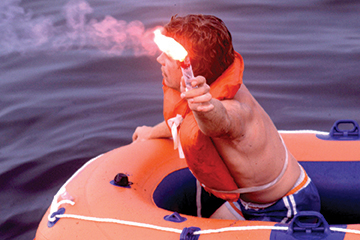 All crew on deck should wear lifejackets. Add extra clothing layers because the helicopter’s downdraft creates a wind chill effect. And, do the right thing for the helicopter’s crew. Pay close attention to the briefing, stay as calm as possible and avoid shining flashlights at the helicopter; the light may blind the pilot and rescue team. For the same reason, never fire aerial flares in the vicinity of a helicopter.
All crew on deck should wear lifejackets. Add extra clothing layers because the helicopter’s downdraft creates a wind chill effect. And, do the right thing for the helicopter’s crew. Pay close attention to the briefing, stay as calm as possible and avoid shining flashlights at the helicopter; the light may blind the pilot and rescue team. For the same reason, never fire aerial flares in the vicinity of a helicopter.
BASKETS AND HORSE COLLARS
Most often, the rescuers will use either a rescue basket, a Stokes litter or a horse collar to lift the victim into the aircraft. The choice of which to use depends on the victim’s medical condition and his or her need to remain horizontal during the hoist. The horizontal position is particularly important for persons with spine injuries or severe hypothermia. Accordingly, rescuers prefer the basket for lifting. It is easy to enter, especially in rough weather, and has positive flotation to prevent sinking. Also, the basket will settle on the sea surface, enabling someone in the water to float into it and fasten the straps.
In some situations, however, rescuers may prefer to use a horse collar sling; a padded loop that is placed over the body, around the back, and underneath the armpits. During the hoist, the line remains in front of the victim’s face. Regardless of whether the rescuers use a basket or horse collar, the victim should always wear a PFD and follow directions for securing the safety straps.
The helicopter builds up static electricity traveling to the rescue scene, and the charge is transferred down the cable to the basket or sling. Allow the device to touch the deck or the water to discharge any static electricity before grasping the support cable. Otherwise, you will experience a strong but nonlethal electric shock. The orange steadying line, which is lowered first, is safe to handle and will not produce any shock.
Unhook the hoist cable from a basket only if it becomes necessary to move the basket below decks. Once unhooked from the basket, release the cable to be hauled back to the helicopter. When it is time for the cable to be lowered again, allow the hook to ground on the vessel and then reattach it to the rescue device.
Never attach the hoist cable or the steadying line to any part of your vessel or life raft, even temporarily. The winch operator, who is intently watching the hoist cable, will instantly sever the cable from the hauling winch to prevent a disaster with the helicopter.
You may also use a life raft as an intermediate rescue platform between your distressed vessel and the helicopter. This is especially useful if your boat’s mast and rigging interfere with the positioning of the helicopter or threaten to entangle the basket hoist. In this situation, allow the raft to drift downwind, attached to your vessel by a line. The helicopter pilot cannot see the raft directly below; therefore, the winch operator guides the rescue operation.
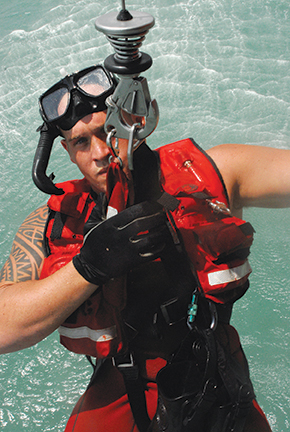 When being winched up by cable and horse collar, follow directions to secure yourself, and wear your life jacket. Since it is much easier to put on the helicopter’s rescue collar when not encumbered by a bulky life vest, if you are wearing an integrated safety harness and inflatable life vest, it may be preferable to leave the vest uninflated when being hoisted.
When being winched up by cable and horse collar, follow directions to secure yourself, and wear your life jacket. Since it is much easier to put on the helicopter’s rescue collar when not encumbered by a bulky life vest, if you are wearing an integrated safety harness and inflatable life vest, it may be preferable to leave the vest uninflated when being hoisted.
As the rescue team picks up survivors from a life raft, the downdraft from the chopper’s blades may capsize the raft, especially if the raft has small ballast pockets. Similarly, rafts loaded to capacity with crew become increasingly unstable as the occupants are removed and winched aboard the helicopter. The survivors should sit on the roof and on the inflated support arch to decrease the amount of surface exposed to the downdraft. Evacuate the strongest crew from the raft last. A rescue swimmer from the helicopter crew will assist when a sick or injured crew member is transferred from the ship, or crew are required to jump into the water to be hoisted aloft.
(Credit to Paul S. Auerbach, Wilderness Medicine, Chapter 83, Safety and Survival at Sea, by Michael E. Jacobs and Charles G. Hawley for the above chapter information.) images courtesy US Coast Guard
ANATOMY OF A RESCUE
The 406-MHz emergency position-indicating radio beacon (EPIRB) sends a digitally coded signal to a low-Earth-orbit satellite, which relays the signal to a nearby ground receiving station (LUT). The location of the EPIRB is calculated and forwarded to the nearest mission control center (MCC), which matches the EPIRB user’s registration with the specific signal. This data is relayed to the local rescue coordination center (RCC), which initiates the search and rescue (courtesy of ACR Electronics).
CHUCK HAWLEY’S HELICOPTER EVACUATION RULES
1. Assign crew to monitor radio and listen for pilot’s radio briefing on channel 16.
2. Activate EPIRB and notify the CG.
3. Secure all loose gear on deck, lower poles, and remove snags.
4. Personnel on deck should wear PFDs (and survival suits, if available).
5. Avoid shining flashlights at helicopter.
6. Never fire aerial flares in direction of helicopter.
7. Maneuver boat so wind is 45° off port bow.
8. Follow commands of CG rescue swimmer.
9. Tend the orange trail line: it’s safe!
10. Discharge static electricity: allow litter or basket to first touch water or boat.
11. Unhook hoist cable if moving the litter below decks.
12. Never attach hook or any other line to the vessel.
13. Secure patient with PFD, blanket, and colored straps.

















